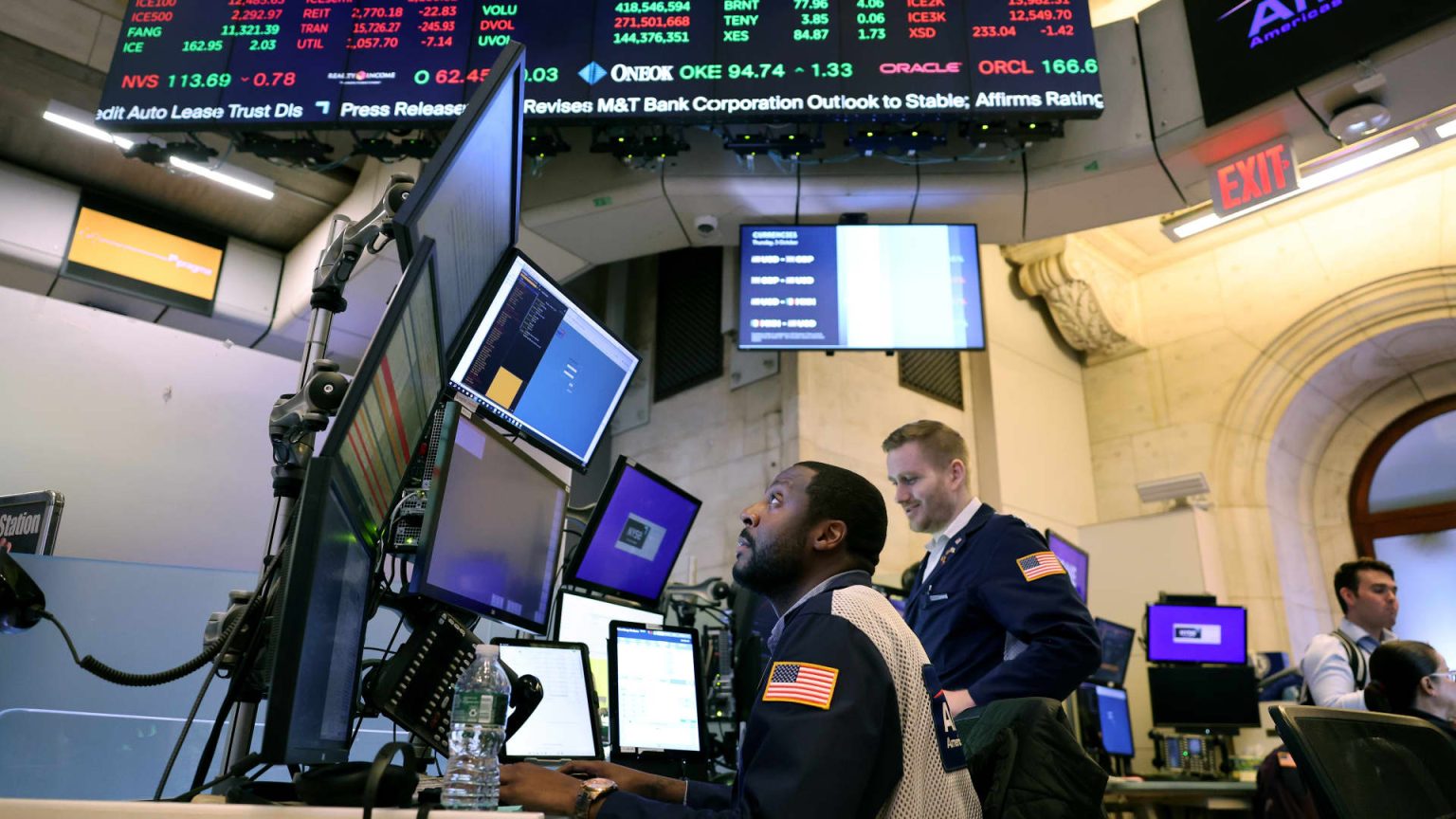Friday’s rally on a strong jobs report gained momentum into the close and pushed the stock market into the green for the week. The S & P 500 , the Dow , and the Nasdaq just barely overcame Tuesday’s sharp losses on rising tensions in the Mideast that boosted oil prices and the CBOE volatility index , commonly referred to as Wall Street’s fear gauge. A silver lining in all this uncertainty: The market has now worked off its overbought condition, moving the S & P Short Range Oscillator into a more neutral position. Should things shift to oversold, we’ll be ready. Aside from a few small buys, we trimmed our stock exposure during the recent run of overbought sessions as our discipline mandates. That boosted our cash position, which stands at around 9.4% of our otherwise all-stock portfolio. The release Friday morning of the government’s September employment data proved to be the big market event we thought it would be. The U.S. economy added 254,000 nonfarm jobs last month, crushing expectations for 150,000. The nation’s unemployment rate ticked down to 4.1%. Economists were expecting an unchanged reading of 4.2%. Hourly earnings increased 4% year-over-year, above the 3.8% estimate and an acceleration from August’s 3.9% gain. Jim Cramer called Friday’s jobs report, the “no landing number,” meaning that moderating inflation and a resilient labor market satisfies both sides of the Federal Reserve’s dual mandate and should result in the status quo rather than a soft economic landing or a hard landing recession. The market now expects 25-basis-point interest rate cuts at the Fed’s November and December meetings following September’s jumbo 50-basis-point cut. That would mean 100 basis points, or 1 percentage point, worth of rate cuts before year-end. Lower short-term policy rates usually translate into cheaper mortgages. However, the longer end of the bond market yield curve has remained stubbornly high — evidenced by Friday’s jump in the 10-year Treasury yield on the jobs report. Home loans loosely follow the 10-year and rates on a 30-year fixed jumped Friday morning to 6.53%, according to Mortgage News Daily . “The only salvation here would be the notion that this is just one jobs report in a recent run that’s been mostly weaker and that perhaps the next one won’t be so damning for bonds,” Matthew Graham, chief operating officer at Mortgage News Daily, told CNBC. The S & P 500 energy sector index was the big winner on the week, rallying over 6.5%, as oil prices increased after Tuesday’s Iran missile attack on Israel and subsequent concerns about how Israel plans to retaliate. President Joe Biden on Friday discouraged Israel from striking Iran’s oil infrastructure. Other forces could also influence oil prices in the coming days and weeks, including Chinese economic stimulus, OPEC+ production curbs, and the end of the three-day U.S. port strike. Also leading to the upside this week sector-wise was communication services, followed by utilities. Materials, on the other hand, led to the downside, followed by real estate and consumer staples. In the week ahead, banks kick off third-quarter earnings season, the government releases two key inflation reports, and Advanced Micro Devices holds an important artificial intelligence event. Inflation data: The September consumer price index (CPI) report is out Thursday. Economists are expecting a 2.2% year-over-year increase at the headline level, and a 3.1% year-over-year increase at the core level, which strips out volatile food and energy prices. In addition to the headline and core numbers, we are still going to watch the CPI’s shelter index, which has been a key underlying source of overall inflation. Any further slowing of year-over-year price increases in shelter would be welcome. The September producer price index (PPI) is out Friday. While the Fed is more concerned about consumer prices, the PPI is still important because if wholesale prices go up more than expected it might mean higher retail prices down the line as companies look to protect their margins. These inflation numbers will certainly figure into the Fed’s calculations concerning future rate cuts. Bank earnings : Wells Fargo is set to report before Friday’s opening bell. Jim said last week that he likes Wells Fargo “very, very much” and thought it should be on investors’ buy list. In addition to the reported quarterly results, we’re interested to hear the bank’s thinking on business ahead now that rates are coming down. Lower rates stand to benefit Wells Fargo’s corporate and investment banking division. We will also be listening for any updates regarding the bank’s Fed-imposed asset cap following the submission of a third-party review of its risk and control overhauls to central bankers last week. We don’t expect any lifting of the cap before 2025 — but even getting a sense of timing on whether it might be a first- or second-half event would help Wall Street analysts sharpen earnings estimates for next year. We’re not so sure about our other bank stock Morgan Stanley , which reports earnings Oct. 16. Bank stocks had a strong session on Friday. Update on AI : Advanced Micro Devices hosts its Advancing AI event on Thursday. Jim said last week that investors who don’t own AMD shares should buy some ahead of CEO Lisa Su’s presentation. Jim thinks Su has a much better artificial intelligence story to tell than people think — pointing to AMD’s quality AI chips for data centers and personal computers. We’ll be looking to see if the AMD event can serve as a catalyst for a catch-up trade given the stock’s relative underperformance year-to-date. AMD stock is up nearly 16% in 2024 compared to a 152% increase in shares of its closest rival Nvidia and an over 20% gain in the SOXX Semiconductor ETF . Week ahead Tuesday, Oct. 8 Before the bell earnings: PepsiCo (PEP) Thursday, Oct. 10 Before the bell: Delta Air Lines (DAL), Domino’s Pizza (DPZ) 8:30 a.m. ET: Initial jobless claims 8:30 a.m. ET: Consumer price index 12 p.m. ET: AMD’s Advancing AI Friday, Oct. 11 8:30 a.m. ET: Producer price index Before the bell: Wells Fargo (WFC), JPMorgan (JPM), BlackRock (BLK) (See here for a full list of the stocks in Jim Cramer’s Charitable Trust.) As a subscriber to the CNBC Investing Club with Jim Cramer, you will receive a trade alert before Jim makes a trade. Jim waits 45 minutes after sending a trade alert before buying or selling a stock in his charitable trust’s portfolio. If Jim has talked about a stock on CNBC TV, he waits 72 hours after issuing the trade alert before executing the trade. THE ABOVE INVESTING CLUB INFORMATION IS SUBJECT TO OUR TERMS AND CONDITIONS AND PRIVACY POLICY , TOGETHER WITH OUR DISCLAIMER . NO FIDUCIARY OBLIGATION OR DUTY EXISTS, OR IS CREATED, BY VIRTUE OF YOUR RECEIPT OF ANY INFORMATION PROVIDED IN CONNECTION WITH THE INVESTING CLUB. NO SPECIFIC OUTCOME OR PROFIT IS GUARANTEED.
Friday’s rally on a strong jobs report gained momentum into the close and pushed the stock market into the green for the week. The S&P 500, the Dow, and the Nasdaq just barely overcame Tuesday’s sharp losses on rising tensions in the Mideast that boosted oil prices and the CBOE volatility index, commonly referred to as Wall Street’s fear gauge.
Read the full article here













